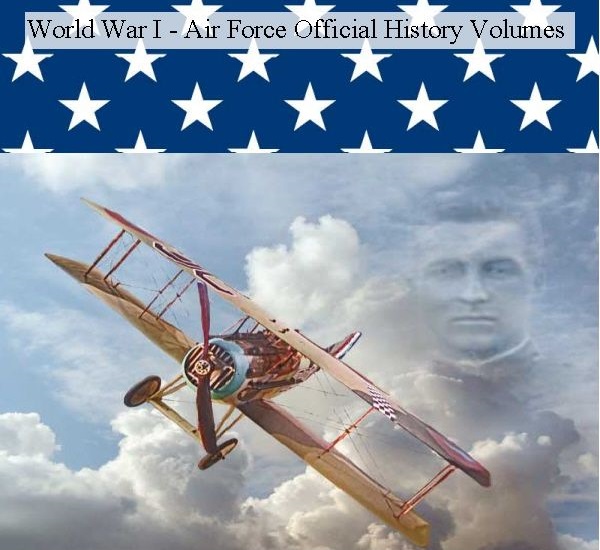
World War I Military Aviation History – Photos – Charts – Diagrams
$19.50
Description
WWI US Air Service: Events, Operations, and Key Figures
Timeline of Main Events in WWI Aviation
- August 1914: World War I begins in Europe. At this time, aviation in the U.S. Army is part of the Signal Corps, primarily focused on observation for infantry and artillery.
- Pre-April 1917: Despite observing aerial operations in Europe and discussions about acquiring combat aircraft, the U.S. Army makes little progress in building a fighting air force or significantly developing observation capabilities before entering the war.
- Spring 1917: The first U.S. airmen arrive in France as part of the American Expeditionary Forces (AEF).
- Wartime Operations (1917-1918): The U.S. Air Service, AEF, engages in a range of activities including:
- Visual and photographic reconnaissance
- Artillery adjustment
- Infantry liaison
- Counter-air operations
- Bombing and strafing in close support of ground forces
- Interdiction of enemy lines of communication
- September 1918: The Battle of St. Mihiel takes place. This is the first battle in France where an American army fights under the American flag. Colonel William “Billy” Mitchell leads the air operations, employing the largest air force assembled to that point. The offensive is successful in eliminating a German salient.
- September – November 1918: The Argonne-Meuse Offensive occurs, in which the U.S. Air Service also plays a significant role.
- November 11, 1918: The Armistice is signed, ending World War I.
- December 1918: Major General Mason M. Patrick, Chief of Air Service, AEF, directs Colonel Edgar S. Gorrell to prepare a history and final report on U.S. air activities in Europe during the war.
- End of WWI (1918-1919): Lieutenant Colonel William C. Sherman and a group of officers in France compile a “Tactical History” of the Air Service, AEF, under Gorrell’s supervision.
- Post-Armistice (1918 onwards): Major General Patrick directs commanders, pilots, observers, and other Air Service members to record lessons learned during the war for future planning.
- 1920: Parts of Lieutenant Colonel Sherman’s “Tactical History” are published in an Air Service Information Circular.
- February 15, 1921: The “Final Report” on U.S. Air Service activities in WWI, prepared under Colonel Gorrell’s direction and submitted by Major General Patrick, is published in an Air Service Information Circular (Aviation), Vol. II, No. 180.
- 1921: The Air Service publishes the “Final Report” in an Information Circular.
- 1948: The Army publishes the “Final Report” in a multi-volume collection of World War I documents.
- 1978: The Office of Air Force History republishes the “Final Report” to reach a wider audience.
- Post-War (Undated): The Air Intelligence Section of General Headquarters, AEF, conducts a post-war investigation into the effects of Allied bombing in World War I, producing a report.
Cast of Characters with Brief Bios
- Major General Mason M. Patrick: Chief of Air Service, American Expeditionary Forces (AEF), at the end of World War I. He initiated the project to create a comprehensive history of U.S. air activities in the war and directed Colonel Gorrell to undertake this task. He believed documenting lessons learned was crucial for the future of the Air Service.
- Colonel Edgar S. Gorrell: Appointed as Assistant Chief of Staff by Major General Patrick in December 1918. He was tasked with directing the preparation of a history and final report on U.S. air activities in Europe during World War I. The narratives and compilations created by Gorrell and his staff formed the basis of the “Final Report.”
- General John J. Pershing: Commander in Chief of the American Expeditionary Forces (AEF). Major General Patrick submitted the “Final Report” on Air Service activities to him.
- Lieutenant Colonel William C. Sherman: Led a group of officers in France at the end of World War I in writing a “Tactical History” of the Air Service, AEF, under the supervision of Colonel Gorrell. This document provided insights into the conduct of combat operations.
- Colonel William (“Billy”) Mitchell: Played a central role in the aerial operations during the Battle of St. Mihiel in September 1918. He is credited with organizing the largest air force committed to battle at that time and developing the plan for its deployment. The Battle of St. Mihiel is considered significant in the history of U.S. military aviation due to his leadership.
World War I Military Aviation History – Photos – Charts – Diagrams
2387 pages of United States military World War I Aviation history in 4 digitalized volumes
In December 1918 Major General Mason M. Patrick, Chief of Air Service, American Expeditionary Forces (AEF), directed his newly appointed Assistant Chief of Staff, Col. Edgar S. Gorrell, to prepare a history and final report on U.S. air activities in Europe during World War I. The narratives written and compiled by Gorrell and his staff were submitted by Patrick to General John J. Pershing, Commander in Chief of the AEF. They summarized Air Service activities from the arrival of the first airmen in France in the spring of 1917 until the Armistice on November 11, 1918. The “Final Report” was published by the Air Service in an information Circular in 1921, and by the Army in a multi-volume collection of World War I documents in 1948. Although it has been used and cited by a number of historians over the years, in 1978, The Office of Air Force History, republished it so as to reach a wider circle of persons interested in the Great War and the early history of military aviation.
Each volume contains, charts, diagrams, and photos. All material in each volume is fully searchable. An auto-index allows searching across all 4 volumes.
The four volumes consist of
The U.S. Air Service in World War I: Volume 1: The Final Report and A Tactical History
The U.S. Air Service in World War I: Volume 2: Early Concepts of Military Aviation
The U.S. Air Service in World War I: Volume 3: The Baffle of St. Mihiel
The U.S. Air Service in World War I: Volume 4: Postwar Review
The U.S. Air Service in World War I: Volume 1: The Final Report and A Tactical History
Topics in Volume I include: A Tactical History of the Air Service; Achievements of the Air Service; The St . Mihiel Offensive; The Argonne-Meuse Offense; Enemy Aircraft Brought Down.
Another important document produced under Gorrell’s supervision as part of the history of the Air Service, AEF, is a “Tactical History” written by Lt. Col. William C. Sherman and a group of officers working with him in France at the end of World War I. Although published in part in an Air Service Information Circular in 1920, Sherman’s “Tactical History” has remained virtually unknown, or at least has not had extensive use. Since it provides excellent information about the conduct of combat operations, it should be of value to persons interested in aerial warfare in the First World War. It has been included, therefore, in this volume with the “Final Report.”
The “Final Report” published in this volume has been taken from Air Service information Circular (Aviation), Vol. II, No. 180, 15 February 1921. Substantive changes made in the Office of the Chief of Air Service when the “Final Report” was being prepared for publication in 1921 have been pointed out in notes provided by the editor.
The U.S. Air Service in World War I: Volume 2: Early Concepts of Military Aviation
This volume contains a comprehensive history U.S. military aviation from 1914 to 1919.
When the Great War began in Europe in August 1914, aviation in the U.S. Army was a function of the Signal Corps. Its mission was to support infantry and artillery by providing observation services. There were people in the Army and outside who could foresee no other military use for aircraft. Others believed that the airplane should be given a combat role. Some thought that aviation should be a separate combat arm.
As news of aerial operations in the European war drifted across the Atlantic, there was more and more talk of buying fighting planes, battle planes, and bomb-dropping planes for the U.S. Army. Although some faltering steps were taken, little progress was made toward building a fighting air force or even toward developing observation services for the ground forces-before the United States entered the war in April 1917.
The wartime operations of the Air Service, AEF, included visual and photographic reconnaissance, artillery adjustment, infantry liaison, counter-air operations, bombing and strafing in close support of ground forces, and interdiction of the enemy’s lines of communications. The war ended before US. units were ready for strategic air operations but thinking on strategic air warfare had advanced far enough to raise, and tentatively answer, questions concerning area versus precision bombing and day versus night operations.
The U.S. Air Service in World War I: Volume 3: The Baffle of St. Mihiel
This volume presents documents relating to the role of U.S. aviation in the Battle of St. Mihiel.
The Battle of St. Mihiel is of singular significance in the history of United States participation in World War I. It was the first battle in France in which an American army fought under the American flag. The US. offensive gained all objectives quickly and with relatively few casualties. It eliminated a menacing salient that had threatened the Allied battleline for four years, and it cleared the way for new offensives that would end the war in less than two months.
Aerial operations at St. Mihiel made the battle an important event in the history of U.S. Military aviation. It was, primarily, Col. William (“Billy”) Mitchell’s show. He put together the largest air force ever committed to battle and drew up the plan for its employment.
The U.S. Air Service in World War I: Volume 4: Postwar Review
Following the Armistice in 1918, Major General Mason M. Patrick, Chief of Air Service, American Expeditionary Forces, directed that a record be made of lessons learned during the war. This information, he believed, was needed for planning the Air Service of the future. The reports prepared by commanders, pilots, observers, and other members of the various Air Service units in response to General Patrick’s directive are of considerable historical interest for the information they contain about the Air Service and its employment at the front. A select group of the reports on lessons learned make up Part I of this volume of World War I documents on U. S. military aviation.
Part II of Volume 4 is devoted to a report on the effects of Allied bombing in World War I. This long-forgotten document, the result of a post-war investigation by the Air Intelligence Section of General Headquarters, American Expeditionary Forces, is the counterpart of the well-known United States Strategic Bombing Survey of World War II.




Related products
-
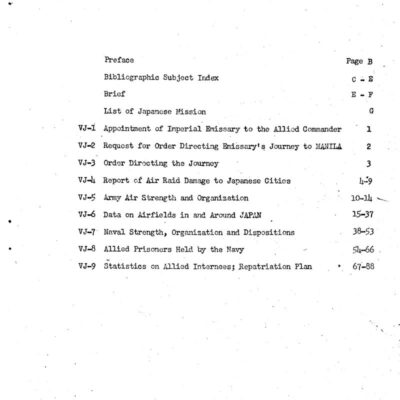
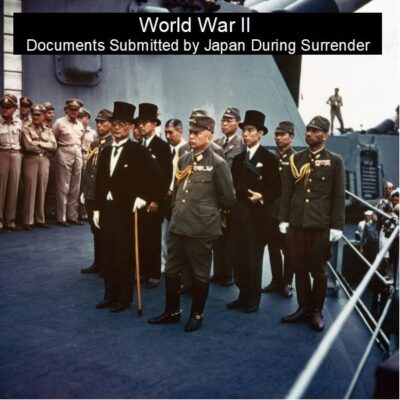
Japan’s Surrender Documents from World War II
$1.99 Add to Cart -
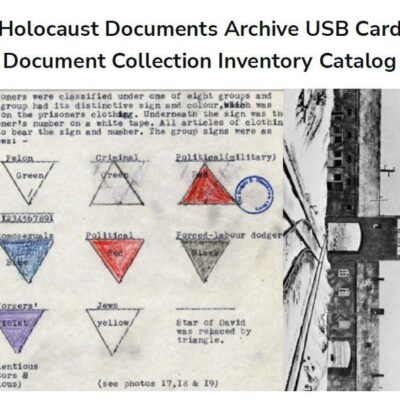
Holocaust Document Archive PDF file – Inventory Catalog of Document Collection
$3.94 Add to Cart -
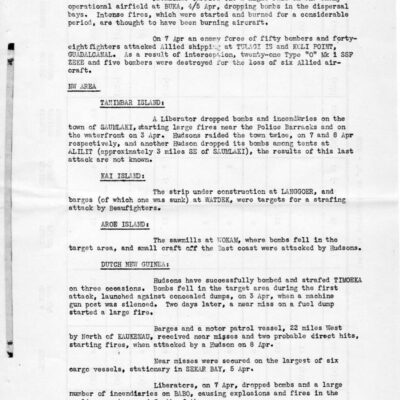
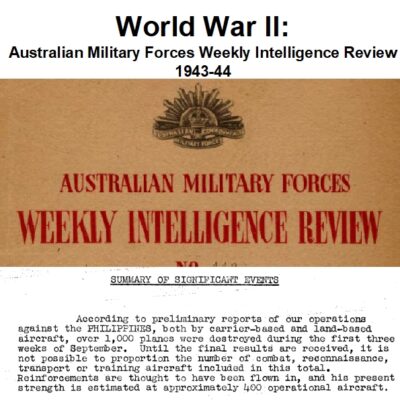
World War II: Australian Military Weekly Intelligence Reports 1943-44
$3.94 Add to Cart -
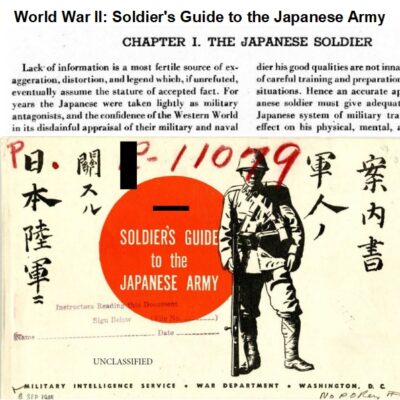

World War II: A Soldier’s Handbook on the Japanese Army
$3.94 Add to Cart